|
|
 |
William Powell Frith
|
|
1819-1909 English painter. His parents were in domestic employment before taking a hotel in Harrogate in 1826. They encouraged him to become an artist, despite his own desire to be an auctioneer. While at school in Dover, Frith sketched caricatures and copies of Dutch genre scenes (Dover Mus.) that betray his disposition to narratives. His taste did not accord with the academic training he received at Henry Sass Academy in London (1835-7) and at the Royal Academy Schools (1837). Frith began his career as a portrait painter, using members of his family as models. He first exhibited at the British Institution in 1838, and during the 1840s he established himself with his entertaining historical and literary subjects in the popular tradition of C. R. Leslie, William Mulready and Sir David Wilkie. He was a member of THE CLIQUE, which included Richard Dadd, Augustus Egg, Henry O Neil and John Phillip. His friendship with Charles Dickens began with commissions for paintings of Dolly Varden (London, V&A) and Kate Nickleby (untraced) in 1842. |
|
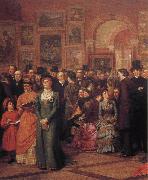 |
William Powell Frith
|
|
English Painter, 1819-1909
His parents were in domestic employment before taking a hotel in Harrogate in 1826. They encouraged him to become an artist, despite his own desire to be an auctioneer. While at school in Dover, Frith sketched caricatures and copies of Dutch genre scenes (Dover Mus.) that betray his disposition to narratives. His taste did not accord with the academic training he received at Henry Sass's Academy in London (1835-7) and at the Royal Academy Schools (1837). Frith began his career as a portrait painter, using members of his family as models. He first exhibited at the British Institution in 1838, and during the 1840s he established himself with his entertaining historical and literary subjects in the popular tradition of C. R. Leslie, William Mulready and Sir David Wilkie. He was a member of THE CLIQUE, which included Richard Dadd, Augustus Egg, Henry O'Neil and John Phillip. |
|
|
|
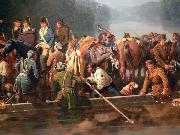 |
William Ranney
|
|
(May 9, 1813 - November 18, 1857) was a 19th-century American painter, known for his depictions of Western life, sporting scenery, historical subjects and portraiture. In his 20-year career, he made 150 paintings and 80 drawings, and is considered the first major genre painter to work in New Jersey, and one of the most important pre-Civil War American painters.His work is on display in several museums across the United States. One of his contemporaries opined, "A specimen of Ranney is indispensable wherever a collection of American art exists." |
|
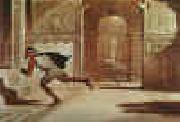 |
William Rimmer
|
|
1816-1879
William Rimmer Gallery
William Rimmer (20 February 1816?C20 August 1879) was an American artist born in Liverpool, England. He was the son of a French refugee, who emigrated to Nova Scotia, where he was joined by his wife and child in 1818, and who in 1826 moved to Boston, where he earned a living as a shoemaker. The son learned the father's trade; at fifteen became a draughtsman and sign-painter; then worked for a lithographer; opened a studio and painted some ecclesiastical pictures.
In 1840 Rimmer made a tour of New England painting portraits, he lived in Randolph, Massachusetts, in 1845-1855 as a shoemaker, for the last years of the decade practising medicine; practised in East Chelsea, Massachusetts and received a diploma from the Suffolk County Medical Society and in 1855 removed to East Milton, Massachusetts where he supplemented his income by carving busts from blocks of granite.
In 1860 Rimmer made his head of St. Stephen and in 1861 his Falling Gladiator. Rimmer's sculptures, except those mentioned and The Fighting Lions, A Dying Centaur, and a statue of Alexander Hamilton (made in 1865 for the city of Boston), were soon destroyed. He worked in clay, not modelling but building up and chiselling; almost always without models or preliminary sketches; and always under technical disadvantages and in great haste; but his sculpture is anatomically remarkable and has an early Greek simplicity and strength.
Rimmer published Elements of Design (1864) and Art Anatomy (1877), but his great work was in the classroom, where his lectures were illustrated with blackboard sketches.
Rimmer's most famous work, though not normally associated with him, is Evening: Fall of Day. This paint-on-canvas portrays Apollo, and a modified version was used by Swan Song Records, the recording label founded in 1974 by English rock group Led Zeppelin, in their label art. It is often mistaken to be a picture of Icarus, Lucifer, Satan, or Daedalus |
|
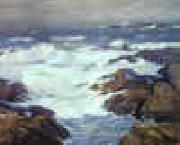 |
William Ritschel
|
|
1864-1949
William Frederic Ritschel (1864-1949) was an impressionist painter who was born in Nuremberg, Germany on July 11, 1864. As a youth, he worked as a sailor and began sketching seascapes. He studied art under Karl Raupp (1837-1918) and Wilhelm von Kaulbach (1805-1874) at the Royal Academy in Munich before immigrating to New York City in 1895. In 1911, he settled in Carmel-by-the-Sea, California and began painting Monterey Peninsula. He died in Carmel in 1949.
The Arizona State University Art Museum (Tempe, Arizona), the Art Institute of Chicago, the Crocker Art Museum (Monterey, California), the Davenport Museum of Art (Davenport, Iawa), Fisher Gallery (University of Southern California, Los Angeles), the Honolulu Academy of Arts, the Irvine Museum (Irvine, California), the Monterey Museum of Art (Monterey, California), the Museum of Art at Brigham Young University (Provo, Utah), the Newark Museum (Newark, New Jersey), the Oakland Museum of California (Oakland, California), the Pennsylvania Academy of the Fine Arts (Philadelphia), the Smithsonian American Art Museum (Washington, D. C.), Springville Museum of Art (Springville, Utah), and the University of Arizona Museum of Art (Tucson, Arizona) are among the public collections holding works by William Frederic Ritschel |
|
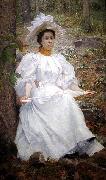 |
William Robinson Leigh
|
|
(September 23, 1866 - March 11, 1955) is a noted American artist, who specialized in Western scenes.
He was born at Maidstone Manor Farm, Berkeley County, West Virginia. He entered the Maryland Institute at age 14, then attended the Royal Academy in Munich. He returned to the United States and worked painting cycloramas and as a magazine illustrator. He married and fathered William Colston Leigh, Sr. (1901-1992).
In 1906, Leigh traveled to the American West and maintained a studio in New York City. In 1933, he wrote and illustrated The Western Pony. He also traveled to Africa and published a book Frontiers of Enchantment (1938). Hs adventures were chronicled in a number of popular magazines including Life, the Saturday Evening Post, and Colliers.He is known for painting the Grand Canyon and Yellowstone National Forest, but his primary interest were the Hopi and Navajo Indians
|
|
|
|
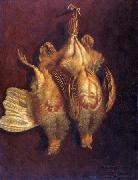 |
William Roos
|
|
William Roos (1808 - 4 July 1878) was a Welsh artist and engraver. Several of Roos' portraits, mainly of notable Welsh figures, are owned by the National Library of Wales.
|
|
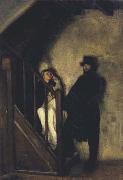 |
William Rothenstein
|
|
English Painter, 1872-1945
English painter, printmaker, teacher and writer. He was the son of a wool merchant and delighted in the grim landscape of his native Yorkshire, which was the subject of some early watercolours. At 16 he left Bradford to attend the Slade School of Art, London (1888-9), where he was a pupil of Alphonse Legros, and the Acad?mie Julian, Paris (1889-93). His talent was recognized as early as 1891, when an exhibition of his work and that of Charles Conder at the Galerie Hadrien Thomas in Paris attracted the attention of many artists including Pissarro and Degas. The latter invited Rothenstein to visit his studio and became a major influence on his development. After an inspiring four years he left Paris for Oxford |
|
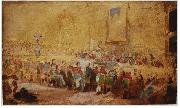 |
William Salter
|
|
painted Sketch of the 1836 Waterloo Banqet by William Salter in 1836 |
|
|
|
|
|
|
|
 |
William Scrots
|
|
William (or Guillim) Scrots (or Scrotes or Stretes) (active 1537-1553) was a painter of the Tudor court and an exponent of the Mannerist style of painting in the Netherlands. He is first heard of when appointed a court painter to Mary of Habsburg, Regent of the Netherlands, in 1537. In England, he followed Hans Holbein as King's Painter to Henry VIII in 1546, with a substantial annual salary of £62 10s, over twice as much as Holbein's thirty pounds a year. He continued in this role during the reign of the boy king Edward VI. His salary was stopped on Edward's death in 1553, after which it is not known what became of him, though it is presumed he left England.
Edward VI, attributed to Scrots, Hampton Court.
Portrait of Edward VI in distorted perspective, 1546.Little more is known of Scrots than that his paintings showed an interest in ingenious techniques and detailed accessories. Scrots was paid 50 marks in 1551 for three "great tables", two of which were portraits of Edward delivered to the ambassadors Thomas Hoby and John Mason as gifts for foreign monarchs, and the third a "picture of the late earle of Surrey attainted." Two full-length portraits of Edward VI in a pose similar to that of Holbein's portrait of his father, one now in the Royal Collection (left) and another now in the Louvre (below), are attributed to Scrots and are likely to be these two paintings. Scrots also painted an anamorphic profile of Edward VI, distorted so that it is impossible to view it normally except from a special angle to the side. This optical trick is similar to that used by Holbein in his painting The Ambassadors and in contemporary portraits of Francis I and Ferdinand I. Later, when the painting was exhibited at Whitehall Palace in the winter of 1591-92, it created a sensation, and important visitors were all taken to see it. |
|
|
|
 |
william shakespeare
|
|
Born: 23 April 1564
Birthplace: Stratford-upon-Avon, England
Died: 23 April 1616
Best Known As: The famed author of Romeo and Juliet |
|
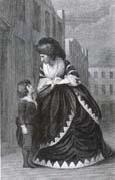 |
William Sharp
|
|
British 1749-1824,was an English line-engraver born in London. He was originally apprenticed to what is called a bright engraver, and practised as a writing engraver, but gradually became inspired by the higher branches of the engraver's art. Among his earlier plates are some illustrations, after Stothard, for the Novelists' Magazine. He engraved the "Doctors Disputing on the Immaculateness of the Virgin" and the "Ecce Homo" of Guido Reni, the "St Cecilia" of Domenichino, the "Virgin and Child" of Dolci, and the portrait of John Hunter of Sir Joshua Reynolds. His style of eta-graving is thoroughly masterly and original, excellent in its play of line and rendering of half-tints and of "colour." He died at Chiswick on the 25th of July 1824. In his youth, owing to his hotly expressed adherence to the politics of Paine and Horne Tooke, he was examined by the privy council on a charge of treason. Mesmer and Brothers found in Sharp a stanch believer; and for long he maintained Joanna Southcott at his own expense. As an engraver he achieved a European reputation, and at the time of his death he enjoyed the honour of being a member of the Imperial Academy of Vienna and of the Royal Academy of Munich. |
|
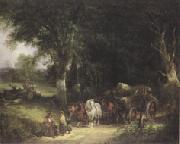 |
William Shayer
|
|
1787-1879
English painter. Although based in Southampton and catering predominantly to a provincial market, he also exhibited in London. Between 1825 and 1870 he showed over 330 works at the Royal Society of British Artists and 80 at the British Institution. Shayer produced rural genre scenes in the manner of Francis Wheatley, Julius Caesar Ibbetson and, predominantly, |
|
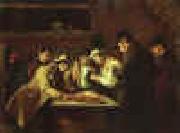 |
William Sidney Mount
|
|
1807-1868
William Sidney Mount Galleries
William Sidney Mount (November 26, 1807 ?C November 19, 1868) born in Setauket, New York was a renowned genre painter and contemporary of the Hudson River School. Mount trained at the National Academy of Design in New York. Two of his more famous paintings are Eel Spearing at Setauket (1845, New York State Historical Association, Cooperstown) and Bargaining for a Horse (1835, New-York Historical Society, New York City). Beginning as a history painter, Mount moved to depicting scenes from everyday life. The largest collection of his works is located in The Long Island Museum of American Art, History, and Carriages
His home and studio, the William Sidney Mount House, is a National Historic Landmark. One of the local elementary schools in The Three Village Central School District is named in his honor, as is PS 174 elementary school in Rego Park, Queens. A residential building is named after him on the Stony Brook University campus. |
|
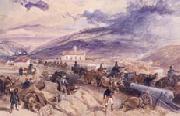 |
William Simpson
|
|
British Painter (1823-1899)
was a British artist and war correspondent. Born into poverty in Glasgow on 28 October 1823, Simpson went on to become one of the leading 'special artists' of his day, and sketched many scenes of war for the Illustrated London News. His early years were very difficult living in a house with an abusive and alcoholic father, and in 1834 he was sent to live with his grandmother in Perth. Simpson's only formal schooling took place during this period and within a few years, he was working as an apprentice in the Glasgow lithographic firm of Macfarlane. The artist stated later that "this was the turning point which changed all my boyish intentions." It was during the years in Glasgow that he attended the Andersonian University and the Mechanics Institute in the evenings. His next position was with the lithographic company of Allan and Ferguson where he spent four years learning the trade. In 1851 Simpson moved to London where he was hired by Day & Sons. While at Day's he was able to work on several important lithographic sets. He became famous initially for his work in the Crimean War where he was sent by the firm of Colnaghi to create a series of watercolors suitable for lithographing. In the late 1850's he was sent to India to sketch scenes relating to the recent Sepoy Revolt. He joined the ILN in 1866 and covered the Abyssinian Campaign of 1868. In 1870 he went to France to sketch the war with Prussia, and in the following year observed the barricades of the Paris Commune. During a trip around the world, he stopped off in California and traveled to the Lava Beds area to report on the Modoc War in 1873. Five years later, he journeyed to Afghanistan to provide illustrations of the Second Afghan War that had broken out; he returned to London in the summer of 1879. In 1890, he observed the opening of the Forth Bridge and caught a chill which was to have detrimental effects on his health. He died at home in Willesden, north London, on August 17, 1899, and was buried in Highgate Cemetery. Besides his war pictures, he covered state events, coronations, funerals, and other ceremonies. He was particularly interested in India and sketched scenes of the Kashmir Maharajas. |
|
|
|
|
|
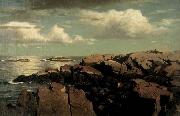 |
William Stanley Haseltine
|
|
(June 11, 1835-February 3, 1900) was an American painter and draftsman who was associated with the Hudson River School and Luminism.
Born in Philadelphia to John Haseltine, a successful businessman, and Elizabeth Shinn Haseltine, an amateur landscape painter, Haseltine studied at the University of Pennsylvania and then at Harvard University, where he received a degree in 1854.
He first exhibited his paintings the following year at the Pennsylvania Academy of Fine Arts, after which he sailed to Europe, first joining a colony of American painters who were studying in Dusseldorf, then traveling up the Rhine into Switzerland and Italy. In late 1857 he settled in Rome, and in the following months made numerous excursions to draw the landscape around Rome and on Capri.
In 1858 Haseltine returned to Philadelphia, and by late 1859 was installed in the Tenth Street Studio Building in New York City, then a central point for American landscape painters; also in the building were Frederic Edwin Church, Albert Bierstadt, and Worthington Whittredge, the latter two having befriended Haseltine in Europe. Though many of his paintings from this time derived from his European sketches, Haseltine also began to paint the oceanside of New England, especially favoring the rockbound coasts of Narragansett, Rhode Island, Nahant, Massachusetts, and Mount Desert Island, Maine. The precision with which he painted these landscapes won critical praise, and Haseltine was elected an Associate of the National Academy of Design in 1860, and a full Academician in 1861.
In 1864 Haseltine's wife died in childbirth. He spent some time training his nephew, Howard Russell Butler, but he moved after he married Helen Marshall in 1866. Initially the family considered settling in Paris, but in 1867 they moved to Rome, which would for most of Haseltine's subsequent years serve as his home and point of departure from which to produce views of the European landscape. While his paintings of Capri and Sicily would prove popular with visiting American tourists, Haseltine also traveled and drew in France, Holland, Belgium, and the Netherlands, summering in Bavaria and the Tyrol in the 1880s and 1890s. In his later years he also returned periodically to the United States, making a final trip to the west in 1899.
Haseltine died of pneumonia in Rome in 1900. |
|
|
|
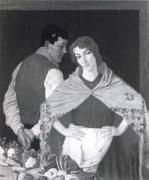 |
William Strang
|
|
British Painter, 1859-1921,Scottish painter and printmaker. Following a brief apprenticeship with a shipbuilding firm in Clydesdale, he entered the Slade School of Art (1876) where he adhered to the uncompromising realism advocated by his teacher Alphonse Legros. After completing his studies at the Slade (1880), Strang became Legros's assistant in the printmaking class for a year. For the next 20 years he worked primarily as an etcher. His etchings include landscapes in the tradition of Rembrandt, pastoral themes indebted to Giorgione and macabre genre subjects, marked by a sense of tension and suspended animation. He also etched 150 portraits of leading artistic and literary figures. The commitment to realism and psychological intensity that characterizes the best of Strang's etched work is also evident in the paintings that dominated the latter half of his career. The influence of the Belgian and French Symbolists' work and Strang's growing confidence in the handling of colour combined in his mature style with a linear clarity and schematic colouring that is best seen in such works as Bank Holiday (1912; London, Tate). His oil portraits, for example Vita Sackville-West as Lady In a Red Hat (1918; Glasgow, A.G. & Mus.), are strikingly potent images of their time. An important collection of Strang's graphic work is in the Art Gallery and Museum in Glasgow. |
|
 |
William Strutt
|
|
English Painter, ca.1825-1915
was an English artist. Strutt was born in Teignmouth, Devon, England, and came from a family of artists, his grandfather, Joseph Strutt, was a well-known author and artist, his father, William Thomas Strutt, was a good miniature painter. William Strutt enjoyed a student life in Paris, France, and England, studying figurative and history painting. In response to a near-breakdown and problems with his eyes, Strutt decided to visit Australia, arriving 5 July 1850 on the Culloden, where he then married. In Melbourne, Strutt found employment as an illustrator on the short-lived Illustrated Australian Magazine, published by Thomas Ham, as there was little demand for the figurative and history paintings for which he was trained. Some of his designs did, however, lead to commissions, including a design for a new postage stamp, and an Anti-Transportation League card. Despite the lack of interest for major history paintings in Melbourne, Strutt continued to sketch suitable subjects, including the "Black Thursday" bushfires, which swept over the colony on 6 February 1851. It was from these sketches that Strutt composed one of his most notable paintings some 10 years later, Black Thursday, February 6th. 1851, 1864, which depicted animals and men fleeing from the fire. In February 1852, Strutt joined the growing tide of men travelling to the gold-fields surrounding Ballarat, Victoria. Despite working in the gold fields for eighteen months he found little success. He returned to Melbourne in mid-1853 and became actively involved in the city's cultural scene, undertaking a number of portrait commissions and joining the Victorian Society of Fine Arts as a founding member. William Strutt, Portrait of John Pascoe Fawkner, founder of Melbourne, 1856: oil on canvas; 61.3 x 51.2 cm. National Library of Australia.Strutt's interest in depicting the notable events of the colony was piqued by the events surrounding the Victorian Exploring Expedition led by Burke and Wills in 1860-61. He made several studies of their preparations at Royal Park, Melbourne, and followed the expedition to its first camp at Essendon, Victoria. Strutt also collected first-hand accounts from the rescue party and from John King, |
|
|
|
|
|
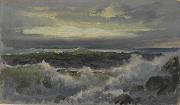 |
William Trost Richards
|
|
(June 3, 1833 - April 17, 1905) was an American landscape artist associated with both the Hudson River School and the American Pre-Raphaelite movement.
William Trost Richards was born on 3 June 1833 in Philadelphia. In 1846 and 1847 he attended the local Central High School. Between 1850 and 1855 he studied part-time with the German artist Paul Weber while working as designer and illustrator of ornamental metalwork. Richards first public showing was part of an exhibition in New Bedford, Massachusetts, organized by artist Albert Bierstadt in 1858. In 1862 he was elected honorary member of the National Academy of Design and Academician in 1871. In 1863, he became a member of the Association of the Advanced of Truth in Art, an American Pre-Raphaelite group. In 1866, he departed for Europe for one year. Upon his return and for the following six years he spent the summers on the East Coast. In the 1870s, he produced many acclaimed watercolor views of the White Mountains, several of which are now in the collection of the Metropolitan Museum of Art. Richards exhibited at the National Academy of Design from 1861 to 1899 and at the Brooklyn Art Association from 1863 to 1885. He was elected a full member of the National Academy in 1871.
Richards rejected the romanticized and stylized approach of other Hudson River painters and instead insisted on meticulous factual renderings. His views of the White Mountains are almost photographic in their realism. In later years, Richards painted almost exclusively marine watercolors.
His works are featured today in many important American museums, including the National Gallery, the Smithsonian American Art Museum, the Wadsworth Atheneum, the Philadelphia Museum of Art, the Yale University Art Gallery, the High Museum of Art, the Museum of Fine Arts, Boston, the Fogg Art Museum, the Brooklyn Museum of Art and the Thyssen-Bornemisza Museum.
|
|
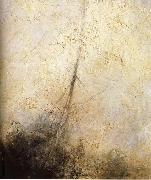 |
William Turner
|
|
English Romantic Painter, 1775-1851
British painter and printmaker. He dominated British landscape painting throughout the first half of the 19th century. He established a reputation in the Royal Academy, London, first as a topographical watercolourist and then within a few years as a painter of Sublime and historical landscapes. |
|
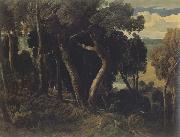 |
William Turner of Oxford
|
|
British, 1789-1862
He probably received his earliest training from William Delamotte, in Oxford. In 1804 he went to London and became a pupil of John Varley, possibly being formally apprenticed. He first exhibited at the Royal Academy in 1807; in January 1808 he was elected an associate of the Society of Painters in Water-Colours, and in November of that year became its youngest full member. He exhibited there annually from 1808 until his death, sending 455 works in all. His passionate, technically complex youthful work was highly acclaimed, yet its promise remained unfulfilled; around 1811 he returned to Oxfordshire and soon established himself as a drawing-master in Oxford. |
|
|
|
|
|
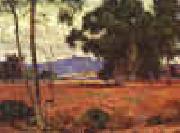 |
William Wendt
|
|
1865-1946
Wendt believed there are philosophical, metaphysical, and theological foundations as to why humankind creates Art. Art becomes a sign in itself that points ultimately towards higher realities than the art object or process manifests in and through itself, courtesy of the artist's knowledge and free-will. Art is an adoration symbol that links the reality of the artist's vision and dream-state to the principles that are nature. Wendt decades in front of nature.
William Wendt found a California at the close of the 19th century which is now lost forever due to the effects of industrialism, consumerism and population density.
Wendt believed nature was a manifestation of God, and he viewed himself as nature's faithful interpreter.
Thom Gianetto of Edenhurst Gallery, Los Angeles, is a specialist in William Wendt. |
|
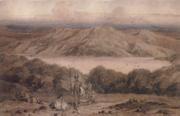 |
William Westall
|
|
English painter and engraver
1781-1850
was an English artist who travelled aboard HMS Investigator on her voyage to Australia. Westall was born in Hertford, England. Westall, like the other botanical artist on HMS Investigator Ferdinand Bauer, was born into an artistic family. His older half brother Richard, was a member of the Royal Academy, and assisted him in securing a place for his younger half brother at the Royal Academy in 1799. During his studies at the Royal Academy Westall's work came to the attention of Joseph Banks, who was at the time keen to find a landscape artist for Matthew Flinders' expedition aboard HMS Investigator. With the support of Banks, Westall was appointed by the Admiralty in London as landscape and topographical artist on HMS Investigator. In 1801, at the age of 19, Westall found himself aboard HMS Investigator. The subsequent voyage of discovery to Terra Australise, has in time come to be regarded as one of the notable scientific and botanical studies ever undertaken. William Westall, King George's Sound in Albany, Western AustraliaWestall began sketching the Australian coast, south of Cape Leeuwin and later on Monday 7 December 1801, King George's Sound, Western Australia, thereby becoming one of the first professional artists to draw the Australian landscape painting. Many of the sketches that Westall created were coastal profiles, to assist with the important task of mapping Australian coastline. The subsequent circumnavigation of Australia took Westall from Cape Leeuwin in Western Australia, across the Great Australian Bight to the South Australian gulf country, to Kangaroo Island, and thence to Port Jackson and the Gulf of Carpentaria. Particularly notable amongst the works created by Westall during the voyage are his accurate portraits of Aboriginal people and the watercolours of their cave paintings, the first European artist to depict the cave paintings. |
|
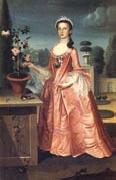 |
William Williams
|
|
English-born American Colonial Era Painter, 1727-1791
was an American painter. He was born in Caerphilly, Wales. He began residing in Philadelphia around 1747 and afterwards in New York City before returning to England about 1780, where he died in Bristol |
|
|
|
william witherington
|
|
William Frederick Witherington (26 May 1785 - 10 April 1865) was an English painter and academic. Born in London, he entered the Royal Academy Schools in 1805. Except for one year he exhibited annually at the Royal Academy from 1811 until his death. He was elected A.R.A. on 1 November 1830 and R.A. on 10 February 1840. He retired as an academician on 28th May 1863.
His early works were mostly landscapes, but the influence of artists like George Morland (1763 - 1804) can be seen in the importance he gave to the figurative element in his paintings.
Witherington enjoyed painting English scenery and never travelled abroad. As with many of his works, he does not depict the harsh realities of rural life, but instead records incidents of family life. Like his contemporary, Augustus Wall Callcott, RA, he creates a composition with a lively foreground of figures and animals, combined with a landscape with distant vistas glimpsed through the wood. |
|
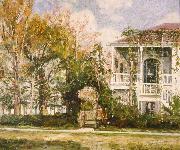 |
William Woodward
|
|
(1 May 1859 - 17 November 1939) was a U.S. artist and educator, best known for his impressionist paintings of New Orleans and the Gulf Coast of the United States.
Woodward was born in Seekonk, Massachusetts. His younger brother Ellsworth Woodward also became a notable artist. William Woodward studied art at the Rhode Island School of Design, and later at the Academie Julian where he received instruction from Gustave Boulanger and Jules Lefebvre.
View of the Napoleon House in New Orleans, 1904In 1884 Woodward was hired to teach fine art, mechanical drawing, and architectural drawing at Tulane University in New Orleans. He became interested in the history and architecture of the city, especially the old French Quarter, which at the time had become largely neglected with many of the historic structures in a state of decay. In 1895 he led a successful campaign to save the Cabildo from demolition. His series of paintings of French Quarter scenes helped shape awareness of the neighborhood's architectural heritage and spurred the formation of the Vieux Carre Commission to help preserve it.
He started teaching architectural engineering at Tulane in 1894 and helped found the Tulane School of Architecture in 1907, as well as the Newcomb School of Art.
In 1921 he suffered an accident and used a wheelchair for the rest of his life. He retired from Tulane the following year, and in 1923 moved to Biloxi, Mississippi. He invented the fiberloid dry etching process. He continued to paint and produce etchings for the rest of his life.
|
|
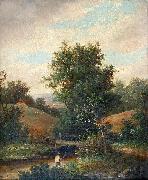 |
William Yates
|
|
painted Fisherman on the River Bank in 19th Century
|
|
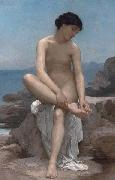 |
William-Adolphe Bouguereau
|
|
(November 30, 1825 - August 19, 1905) was a French academic painter. William Bouguereau was a traditionalist whose realistic genre paintings and mythological themes were modern interpretations of Classical subjects with a heavy emphasis on the female human body.
William-Adolphe Bouguereau was born in La Rochelle, France on November 30, 1825, into a family of wine and olive oil merchants. He seemed destined to join the family business but for the intervention of his uncle Eugene, a Roman Catholic priest, who taught him classical and Biblical subjects, and arranged for Bouguereau to go to high school. Bouguereau showed artistic talent early on and his father was convinced by a client to send him to the École des Beaux-Arts in Bordeaux, where he won first prize in figure painting for a depiction of Saint Roch. To earn extra money, he designed labels for jams and preserves |
|
|
|
|
|
|
|
|
|
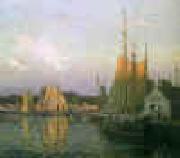 |
Wilson Irvine
|
|
1869-1936
Wilson Henry Irvine Galleries
Wilson Henry Irvine (28 February 1869-1936) was a master American Impressionist landscape painter. Although most closely associated with the Old Lyme, Connecticut art colony headed by Florence Griswold, Irvine spent his early career near Chicago, a product of the School of the Art Institute of Chicago. Irvine also painted across Western Europe ?? where he produced outstanding American Impressionist versions of the local countryside.
Today, Wilson Irvine's paintings grace the collection of Chicago's Art Institute, as well as other notable collections strong in American Impressionism, including: Old Lyme's Florence Griswold Museum; Washington, D.C.'s Smithsonian Institution National Portrait Gallery and Corcoran Gallery of Art; and Chicago's Union League Club.
Irvine is best known for his mastery of light and texture ?? a 1998 exhibit of his work was called Wilson Henry Irvine and the Poetry of Light. To capture subtle effects of light, Irvine often painted en plein air ?? wearing his trademark cap, knickers, and goatee, with his easel and his paints set up in the field.
Sometimes Irvine's obsession with light led him to paint rather pedestrian subjects ?? landscapes depicting little more than some trees, or a road or fence. But a number of Irvine masterpieces depict well-composed scenes including houses, boats, bridges ?? even a handful of portraits, including at least one self-portrait and a nude.
Wilson Henry Irvine, born near Byron, Illinois, was a descendant of early Illinois settlers and farmers. Wilson channeled his family's agrarian interests into a painter's eye for landscape.
From the beginning, Irvine's interest in painterly subjects was equalled by a parallel focus on artistic technology. While still in his 20s, Irvine was a pioneer of the airbrush as artistic medium ?? a medium which had just been developed and marketed by Liberty Walkup, Irvine's Illinois neighbor, mentor, and teacher.
Having mastered the airbrush, in 1888 Irvine moved to Chicago to make his reputation. Irvine's "day job" during this period was as an illustrator/graphic designer, often employing the still-novel airbrush. But simultaneously, Irvine built a career as a serious painter. He worked his way up Chicago art society ?? he led the Palette and Chisel Club and Cliff Dwellers Club, along with sculptor Loredo Taft.
During these years, Irvine gravitated to the night school of the famed Art Institute of Chicago, where he studied for over seven years. Indeed, the Art Institute was to remain a loyal patron. By the turn of the century, the Institute often showed Irvine's work, and gave him a prestigious solo show over the 1916-1917 Christmas season. To this day, the Art Institute maintains a number of Wilson Irvine paintings in its permanent collection. |
|
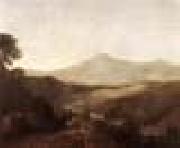 |
WILSON, Richard
|
|
Welsh Romantic Painter, ca.1713-1782
British landscape painter, b. Wales. He studied in London and achieved success as a portrait painter, but after a visit to Italy (c.1750?C1756) he devoted himself to landscape in the classical tradition of Claude Lorrain. The exhibition of Wilson's Niobe in 1760 won him acclaim, and he was made a member and later librarian of the Royal Academy. His work did not become generally popular until after his death. Although his Italian landscapes did not depart from the classical tradition of picturesque Roman ruins and recumbent nymphs, his work shows considerable originality and breadth of treatment, especially in his many fine paintings of English country houses. He exerted a strong influence on subsequent landscape painting in England. On Hounslow Heath (National Gall., London) and Afternoon and Lake Nemi |
|
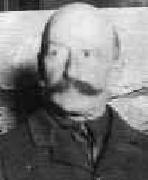 |
Winslow Homer
|
|
1836-1910
Winslow Homer Locations
Winslow Homer (February 24, 1836 ?C September 29, 1910) was an American landscape painter and printmaker, best known for his marine subjects. He is considered one of the foremost painters in 19th century America and a preeminent figure in American art.
Largely self-taught, Homer began his career working as a commercial illustrator. He subsequently took up oil painting and produced major studio works characterized by the weight and density he exploited from the medium. He also worked extensively in watercolor, creating a fluid and prolific oeuvre, primarily chronicling his working vacations. |
|
|
|
 |
WIT, Jacob de
|
|
Dutch Rococo Era Painter, 1695-1754
Dutch painter, draughtsman, etcher and writer. He was the leading 18th-century Dutch decorative painter, specializing in Rococo ceiling and room decorations and groups of putti painted naturalistically in colour or as imitation reliefs in grisaille. His preparatory drawings for ceiling decorations were collected during his own lifetime, but he also executed independent finished drawings specifically for collectors |
|
|

